Acrab, Beta Scorpii Aa (β Sco Aa) is the primary component in a multiple star system located approximately 400 light-years away in the southern constellation of Scorpius. With an apparent magnitude of 2.62, it is the seventh brightest star in Scorpius. It is part of a conspicuous asterism that represents the Scorpion’s claws.
Star system
The Beta Scorpii system is composed of at least six components arranged in two groups. The components are mostly hot, blue stars of the spectral type B. The estimated age of the system is around 6 million years.
Beta1 Scorpii, the brighter of the two visual components, has an apparent magnitude of 2.62. The fainter Beta2 Scorpii shines at magnitude 4.92. Beta1 and Beta2 Scorpii are separated by 13.5 arcseconds and can be resolved in small telescopes. Beta1 appears west of Beta2.
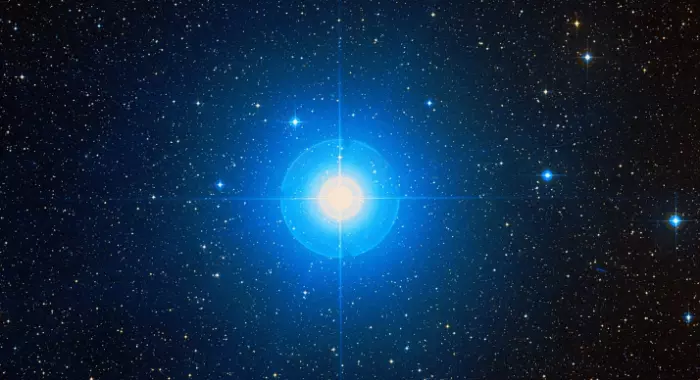
Acrab (Beta Scorpii), image: Wikisky
Beta1 Scorpii consists of three components, a spectroscopic binary pair (Beta Scorpii A) and a single star (Beta Scorpii B). Beta Scorpii A and B have an orbital period of 610 years and are separated by 0.3 arcseconds in the sky.
The two components of Beta Scorpii A – Beta Scorpii Aa and Beta Scorpii Ab – are separated by only 1.42 milliarcseconds and orbit each other with a period of 6.82 days. They have a combined spectral type B1 V and individual spectral classifications of B0.5 and B1.5. The brighter component has the luminosity class between a subgiant (IV) and a main sequence star (V), while the companion star is still on the main sequence. Both components are supernova candidates.
The primary component, Beta Scorpii Aa, has a mass 15 times that of the Sun and a radius 6.3 times solar. With a surface temperature of 28,000 K, it shines with 31,600 solar luminosities.
The companion, Beta Scorpii Ab, has a mass of 10.4 solar masses and a radius 4 times that of the Sun. With an effective temperature of 26,400 K, it is 7,900 times more luminous than the Sun.
The properties of Beta Scorpii B are not well known. The star is more than 20 times fainter than Beta Scorpii A. It is believed to have a mass about 8 times that of the Sun.
Beta2 Scorpii is also composed of a spectroscopic binary star (Beta Scorpii E) and a single star (Beta Scorpii C). The components C and E have an orbital period of 39 years and are separated by 0.1328 arcseconds. The components of Beta Scorpii E – Beta Scorpii Ea and Beta Scorpii Eb – complete an orbit in only 10.7 days.
Beta Scorpii C is a hot blue main sequence star of the spectral type B2 V. It has 8.2 times the Sun’s mass and a radius of 2.9 solar radii. The star is 3,200 times more luminous than the Sun, with an effective temperature of 24,000 K. It spins with a projected rotational velocity of 55 km/s.
Beta Scorpii Ea is 3.5 times more massive than the Sun and has a radius 2.4 times the Sun’s. With a surface temperature of 13,000 K, it has an energy output 126 times that of the Sun. It spins at 5 km/s. Beta Scorpii Ea is a chemically peculiar star. It has high abundances of manganese and strontium. It may be a mercury-manganese star, but it has unusually low abundances of other heavy elements.
The star referred to as Beta Scorpii D is a line-of-sight companion, catalogued as HD 144273. The seventh-magnitude star is separated by 520 arcseconds from the other components.
The Beta Scorpii star system may have another component. Astronomers have proposed that the component Beta Scorpii B may have an unseen companion, referred to as Beta Scorpii G. However, the presence of the companion has never been directly found.
Facts
Acrab forms the Scorpion’s claws with Dschubba (Delta Scorpii), Fang (Pi Scorpii), and Jabbah (Nu Scorpii). The claws once extended into the neighbouring Libra before it became a separate constellation, while Acrab was part of the Scorpion’s forehead. Historically, Acrab, Dschubba and Fang formed an asterism called the Crown of the Scorpion, which represented the head of the Scorpion.
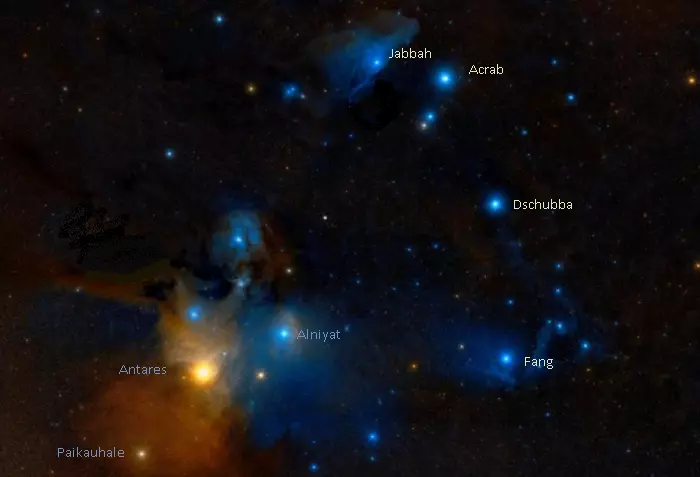
Scorpion’s Claws, image: Wikisky
The Acrab system is a member of the Scorpius-Centaurus association, the nearest OB association to the Sun. Acrab belongs to the Upper Scorpius subgroup, like many other bright young stars that appear in this area of the sky, including Antares (Alpha Scorpii), Dschubba (Delta Scorpii), Fang (Pi Scorpii), Alniyat (Sigma Scorpii), Paikauhale (Tau Scorpii), Pipirima (Mu2 Scorpii), Iklil (Rho Scorpii), Zeta Ophiuchi, and Theta Ophiuchi. The members of the Scorpius-Centaurus association are hot, luminous O- and B-type stars that lie at an average distance of 470 light-years and have a mean age of 11 million years.
Acrab lies only 1.01 degrees from the ecliptic (the path that the Sun appears to cross over the course of a year). The star can be occulted by the Moon and, much less frequently, by planets. An occultation by Venus was recorded on December 9, 1906. On December 9, 1802, Acrab was occulted by Mercury and, on February 28th, 1876, by Jupiter. The last occultation by a planet was observed on May 13, 1971, when the star was occulted by Jupiter and its satellite Io.
Acrab is one of the 27 bright stars represented on the flag of Brazil. Each star corresponds to a Brazilian Federal Unit and Acrab symbolizes the state of Maranhão. Other Scorpius stars featured on the Brazilian flag are Antares (Alpha Scorpii), Larawag (Epsilon Scorpii), Sargas (Theta Scorpii), Iota Scorpii, Kappa Scorpii, Shaula (Lambda Scorpii), and Pipirima and Xamidimura (Mu Scorpii).
Name
The name Acrab (pronunciation: /ˈækræb/) comes from the Arabic al-‘Aqrab, meaning “the scorpion.” It was traditionally also spelled Elacrab and Akrab.
The name was approved by the International Astronomical Union’s (IAU) Working Group on Star Names (WGSN) on August 21, 2016. It formally applies only to the component Beta Scorpii Aa but was historically used for the whole star system.
Beta Scorpii was traditionally also known as Graffias, meaning “claws.” Acrab shared this name with the fainter Xi Scorpii. The name was also sometimes used for Zeta Scorpii and 48 Librae.
In Chinese astronomy, Acrab was known as 房宿四 (Fáng Xiù sì), the Fourth Star of Room. The star formed the Room asterism with Fang (Pi Scorpii), Iklil (Rho Scorpii), and Dschubba (Delta Scorpii). The asterism was part of the larger Room mansion, which represented the abdomen of the Azure Dragon.
Location
Acrab is easy to find because it is part of the distinctive star pattern that represents the claws of the celestial Scorpion. It is the northernmost of the three brighter stars that outline the claws. It appears northwest of Antares and the Fish Hook in Scorpius and the Teapot in Sagittarius. The Scorpion’s claws appear near the bright band of the Milky Way galaxy. For observers in the northern hemisphere, Scorpius appears in the southern sky.
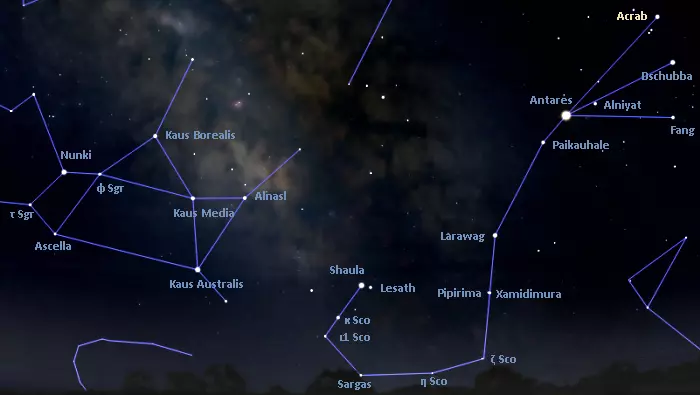
The location of Acrab (Beta Scorpii), image: Stellarium
Acrab can be used to find the bright globular cluster Messier 80, which lies about halfway between the star and Antares. Acrab also lies in the vicinity of the Blue Horsehead Nebula, a reflection nebula illuminated by the fainter Jabbah (Nu Scorpii).
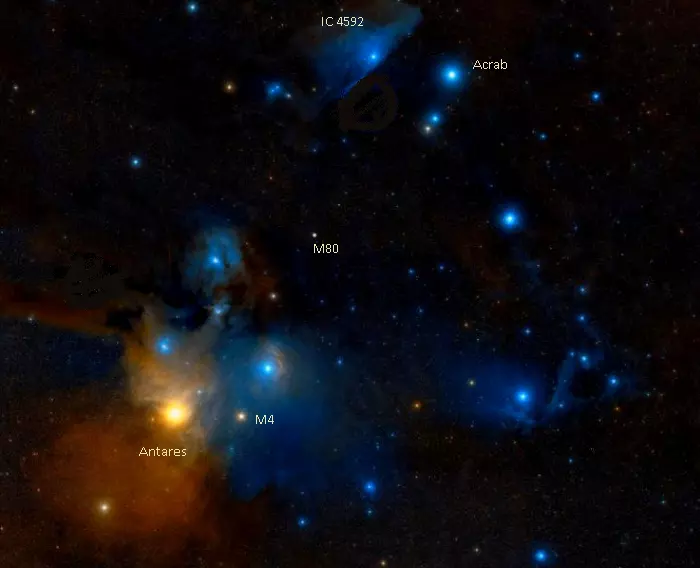
Antares, Acrab and Messier 80, image: Wikisky
Constellation
Acrab is located in the constellation Scorpius. The southern zodiac constellation is one of the 48 ancient constellations catalogued by Claudius Ptolemy of Alexandria in his Almagest in the 2nd century CE. In Greek mythology, it is associated with the scorpion sent by the goddess Gaia to sting Orion, the Hunter.
Scorpius is the 33rd largest constellation in size, stretching across 497 square degrees of the sky south of the celestial equator. It is one of the brightest southern constellations, with 13 stars brighter than magnitude 3.0, including the red supergiant Antares, the 15th brightest star in the night sky.
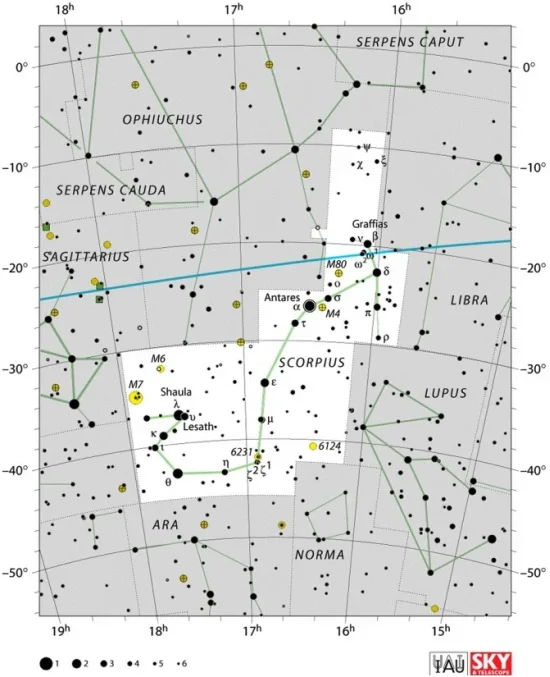
Scorpius constellation map by IAU and Sky&Telescope magazine
Antares, the constellation’s brightest star, marks the Scorpion’s heart and is part of the Fish Hook, a prominent asterism formed by a curved line of stars that ends with the bright Shaula at the Scorpion’s stinger. Shaula, the second brightest star in Scorpius, is a triple star system composed of two luminous, hot, blue B-type main sequence stars and a much younger companion that has not yet evolved onto the main sequence.
Other notable stars in the constellation include the F-type supergiant Iota1 Scorpii, the orange giant Larawag (Epsilon Scorpii), the B-type subgiant Lesath (Upsilon Scorpii), the binary star systems Theta Scorpii (Sargas), Delta Scorpii (Dschubba), and Kappa Scorpii, and the multiple star system Sigma Scorpii (Alniyat). Scorpius also hosts the O-type supergiants V973 Scorpii and the binary pair V918 Scorpii, which shine at fifth magnitude from thousands of light-years away.
The constellation is home to many bright deep sky objects. The best-known ones include the planetary nebula NGC 6302 (the Butterfly Nebula), the star-forming nebulae NGC 6334 (the Cat’s Paw Nebula or Bear’s Claw Nebula) and NGC 6357 (the Lobster Nebula or War and Peace Nebula), the globular clusters Messier 4, Messier 80, and NGC 6144, and the open clusters Messier 6 (the Butterfly Cluster), Messier 7 (the Ptolemy Cluster), and the Northern Jewel Box Cluster (NGC 6231).
The best time of the year to observe the stars and deep sky objects in Scorpius is during the month of July, when the constellation is prominent in the evening sky. The entire constellation is visible from locations south of the latitude 40° N.
The 10 brightest stars in Scorpius are Antares (Alpha Sco A, mag. 0.6 – 1.6), Shaula (Lambda Sco A, mag. 1.62), Sargas (Theta Sco A, mag. 1.84), Dschubba (Delta Sco, mag 2.307), Larawag (Epsilon Sco, mag. 2.31), Kappa Scorpii (mag. 2.39), Acrab (Beta Sco, mag. 2.62), Lesath (Upsilon Sco, mag. 2.70), Paikauhale (Tau Sco, mag. 2.82), and Fang (Pi Sco, mag. 2.89).
Acrab – Beta Scorpii
| Spectral class | B1V + B2V |
| Apparent magnitude | 2.62 + 4.92 |
| Constellation | Scorpius |
| Right ascension | 16h 05m 26.23s |
| Declination | -19° 48′ 19.4” |
| Names and designations | Beta Scorpii, β Sco, Acrab, 8 Scorpii, Elacrab, Graffias, UBV 13616, IRAS 16025-1940, ADS 9913 ABC, IDS 15596-1932, CCDM J16054-1948ABC, WDS J16054-1948 |
Beta1 Scorpii
| Spectral class | B1 V (B0.5IV-V + B1.5V) |
| U-B colour index | –0.08 |
| B-V colour index | –0.08 |
| Apparent magnitude | 2.62 |
| Absolute magnitude | –3.92 / –2.60 |
| Distance | 400 ± 40 light-years (120 ± 10 parsecs) |
| Parallax | 8.07 ± 0.78 mas |
| Radial velocity | –1.0 ± 0.9 km/s |
| Proper motion | RA: –5.20 ± 0.92 mas/yr |
| Dec.: –24.04 ± 0.64 mas/yr | |
| Right ascension | 16h 05m 26.2319826s |
| Declination | –19° 48′ 19.630018″ |
| Names and designations | Beta1 Scorpii, β1 Sco, Acrab, HD 144217, HR 5984, HIP 78820, BD–19 4307, FK5 597, SAO 159682, GC 21609, GCRV 9245, ALS 14816, CPD-19 5945, PPM 231174, PLX 3640.00, 2MASS J16052624-1948185, UBV 13614, TYC 6208-1623-1, Gaia DR2 6247207266936828288, Gaia DR3 6247207266946218112, ADS 9913 AB, CCDM J16054-1948AB, WDS J16054-1948AB |
Beta1 Scorpii A
| Mass (β Sco Aa, β Sco Ab) | 15.0 M☉, 10.4 M☉ |
| Luminosity (β Sco Aa, β Sco Ab) | 31,600 L☉, 7,900 L☉ |
| Radius (β Sco Aa, β Sco Ab) | 6.3 R☉, 4 R☉ |
| Temperature (β Sco Aa, β Sco Ab) | 28,000 K, 26,400 K |
Beta1 Scorpii B
| Mass | ~8 M☉ |
Beta2 Scorpii
| Spectral class | B2V |
| U-B colour index | –0.70 |
| B-V colour index | –0.02 |
| Apparent magnitude | 4.92 |
| Absolute magnitude | –1.83 (Ea: +0.24) |
| Distance | 400 light-years (120 parsecs) |
| Parallax | 8.2368 ± 0.5003 mas |
| Radial velocity | -5.60 ± 0.8 km/s |
| Proper motion | RA: -18.472 ± 0.545 mas/yr |
| Dec.: -15.594 ± 0.363 mas/yr | |
| Right ascension | 16h 05m 26.5686169680s |
| Declination | –19° 48′ 06.845424840″ |
| Names and designations | Beta2 Scorpii, β2 Sco, HD 144218, HR 5985, HIP 78821, BD–19 4308, SAO 159683, ALS 15975, GC 21610, GCRV 9246, PPM 231175, 2MASS J16052655-1948066, UBV 13615, TYC 6208-1622-1, Gaia DR2 6247207266944651648, Gaia DR3 6247207266944651648, ADS 9913 C, CCDM J16054-1948C, WDS J16054-1948CE |
Beta2 Scorpii C
| Mass | 8.2 M☉ |
| Luminosity | 3,200 L☉ |
| Radius | 2.9 R☉ |
| Temperature | 24,000 K |
| Rotational velocity | 55 km/s |
| Surface gravity | 3.8 cgs |
Beta2 Scorpii E
| Absolute magnitude (β Sco Ea) | +0.24 |
| Mass (β Sco Ea) | 3.5 M☉ |
| Luminosity (β Sco Ea) | 126 L☉ |
| Radius (β Sco Ea) | 2.4 R☉ |
| Temperature (β Sco Ea) | 13,000 K |
| Rotational velocity (β Sco Ea) | 5 km/s |
| Surface gravity (β Sco Ea) | 4.2 cgs |